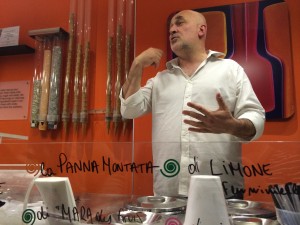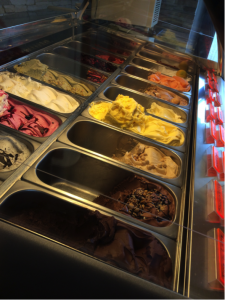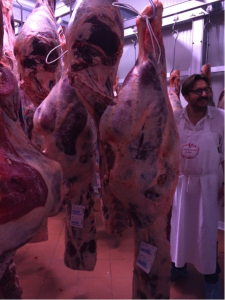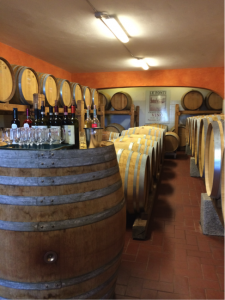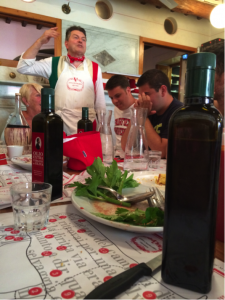by Stephanie Roulier
Do marketing strategies skew the line between beauty and truth—can there be no marketing strategy at all? Producers put themselves in a position such that their product may entice the consumer. Consumers often believe that the producer really does have a higher knowledge in the product, evident by their pure pride in their work or wares. With gelato, wine, and meat, customers are sold an experience, a product that has an inherent aesthetic appeal. Each producer has his or her own marketing strategy, and upon comparing the differences, there are clearly more extremes that these producers go through than meets the eye, just to attract even one more buyer. While studying various producers who create high quality products throughout my stay in Tuscany, I have been able to discover underlying patterns among the marketing strategies of producers. This paper will discuss such realizations, relating to gelaterias, vineyards, and Dario Cecchini’s butcher shop.
~Gelato~
For instance, gelato, an integral part of every Italian’s (and tourist’s) diet, and the success of the gelateria, depends heavily on marketing and presentation of the gelato shop’s offerings. From the way the ice creams are displayed, to the décor of the shop, to the variety of flavors, each shop has its own way of attracting consumers. What many consumers do not realize, however, is that though the ice cream may look fancy and delectable, artificial ingredients are sometimes added to the ice creams to create high piles of gelato, causing one to “oo and ahh” at the site of the frozen treat. That presentation of the ice cream can be quite a spectacle for tourists, though those who truly know quality gelato can understand that only artificial ingredients would allow for the gelato to look so mountainous. Additionally, producers will design their shops in attractive ways, to entice customers. Some shops take the more modern approach, with their ice creams in circular cylinder canisters, while others go for a more classic and vintage feel, with old-fashioned registers, chairs, and countertops. Even still, names of ice creams and the uniqueness of flavors can draw consumers in. Flavors such as strawberry sage, salted caramel, and olive can attract many different gelato enthusiasts. It is this aesthetic appeal of the shops and the flavors of gelato that reel in consumers. One can wonder if the producers who choose to use artificial ingredients to make a spectacle of their gelato are doing wrong. Though they aren’t necessarily lying to their consumers, they do often use a tricky marketing technique to attract buyers, and to play with levels of aesthetic appeal.
When one is searching for gelato shops, it depends on the person’s desires, as well as their palate. Are they well-educated in gelato, or gelato making for that matter? Do they truly understand what makes an excellent gelato? Few, fresh ingredients is the answer to that question, though many will simply be drawn in to the spectacle, regardless of what is actually in the frozen treat. The food space that the consumer falls into can also heavily impact at which shop the person lands in—being in the top right quadrant, with high culture and capital should allow for a superb ice cream experience. At the gelateria De’ Coltelli in Pisa, we were treated with quite the gelato experience. The owner of the shop allowed us to sample almost all of the shop’s flavors, putting on an incredible spectacle. He explained that only the freshest, seasonal, and top quality ingredients are selected for their gelato, and no artificial ingredients are used. A sign on the wall details the same statement, a clever marketing strategy for inquiring customers. This high quality product is absolutely worth the journey to visit, and I believe that their emphasis on fresh ingredients truly does make the ice cream experience that much better. It is as if this is the true beauty of gelato—simple and fresh ingredients blended to create a product that the owner is incredibly passionate about and eager to share with customers of all areas of cultural finesse.
~Vino~
In another more sophisticated realm, we find wine. From labeling to wine tasting, the experience one receives when purchasing a bottle of wine is crucial in keeping vineyards high on the market. Right down to the tasting rooms themselves, wine producers make, or rather their chosen marketing representative, make it a point to attempt to reel in buyers. Through our many visits to vineyards during the trip, I have noticed that each vineyard has its own personal touch on the beautification and aesthetic appeal of their product. For instance, at Le Cinciole, the wine tasting room had comfortable couches, chairs and antique furniture, with a view of the vineyards from the windows. This room put one in a more quaint and special mood, emphasizing that the tasting was focused on the consumer only—the room was there solely for them. At Nittardi, the tasting was held in the room where all of the paintings that were used for their Chianti Classico wine labels and wrapping paper were hung. This room was aesthetically pleasing, in the sense that I felt as though I was in an art gallery. This was impressive, and would be impressive to art enthusiasts alike, as every painting was dedicated to Nittardi’s wine. Even more impressive was the fact that Yoko Ono had created a label for them not too long ago. From this room, consumers get a full picture and idea of the appreciation of art that Nittardi has, so, especially for those interested in art, this wine tasting room is an incredible selling point and marketing strategy. On the other hand, at Le Fonti, the tasting was in one of their wine cellars, with many barrels of aging wine, the smell of the wine lingering throughout the room. Such smells created a vintage and personal feel so that all of the flavors of the wine could be brought out in the air. Though the tasting room wasn’t a posh, special room, it did create a more authentic feel, transporting us to that next level of tasting through all of the wonderful smells in the air of oak and grapes.
However, Le Mortelle exhibited the ultimate spectacle, right down to the outfit of the woman giving the tour. At the other vineyards we visited, the owner of the vineyards spoke with us personally, though at Le Mortelle, a very animated woman dressed in a cocktail dress walked the group around the cellar and processing rooms, trying to reel in those who were there through her enthusiastic words and hand gestures. Using a separate guide seems somewhat disconnected in a sense to me, as the person giving the tour may or may not truly know about the wines, thus what they say often sounds rehearsed or not as unique and special. Nevertheless, Le Mortelle’s wine cellar was truly amazing. The building was massive, the metal wine holding tanks reaching up three stories and a large spiral staircase leading down to the cellar. It seemed as though the structure was coming straight out of a movie. A large floor-to-ceiling glass window stood at the other end of the building, revealing rolling hills dotted by trees and covered in rows upon rows of beautiful green vineyards. The guide spoke of how the estate is very environmentally conscious, reusing CO2 to promote photosynthesis in the plants, recycling water, and the fact that the cellar is built in to a hill. These facts seemed as though they were yet another marketing strategy to impress the potential buyers, especially those who are environment enthusiasts. To top it off, the cellar at the very bottom circled around the entire building, and was controlled by a panel of touch screen buttons. In the center was a table set up for exclusive guests who desired to dine there privately. The entire tour was interesting and aesthetically pleasing, though to me, the tour seemed very superficial, over the top, and almost too much for a vineyard. Their marketing strategies are clearly focused on the beautification of wine, almost to an extreme. Whether it is the goal of the producers to create a more exclusive feel or not, I believe that sometimes extravagance pales in comparison to the beauty of simplicity. Personally, a smaller vineyard that has the owner present truly offers the ultimate package.
~Carne~
Lastly, the way the butchers present and explain their meat products can play a vital role in attracting consumers. In relation to Dario Cecchini’s butcher shop, Dario details how the cows are raised humanely, live long and healthy lives, and are killed with compassion. This often pleases those who are focused on animal rights and do not wish to eat animals raised on CAFOs. Upon visiting his small farm of cows in Panzano, one can see that the cows do seem healthier and are allowed to walk a bit more freely. These cows are slaughtered at the age of eleven, living long lives and “killed with compassion,” as Dario says. However, many of the things that Dario and his assistants present are marketing strategies. The small farm in Panzano is a way of increasing the aesthetic appeal of his meats, causing consumers to become even more wrapped up in the experience of interacting with Dario’s shop. Though he is honest and upfront with everything, it may come as a shock to some that most of his meat comes from cows who are raised in Spain and killed after just two years of life. That small farm in Panzano doesn’t produce nearly the amount of meat that the young cattle in Spain do. Dario’s assistant did explain that those cows are raised humanely, though because we cannot see those cows personally, there is a bit of disconnect. Regardless, what Dario is doing is a great and wonderful idea in terms of animal ethics and rights. At his dinners and in his butcher shop, Dario is very eager to explain passionately his philosophies, inspiring those who are listening to have more compassion for animals and to be more wary of the meat that they are consuming. Right down to the beautiful décor and artfully designed placemats that show the various cuts of the cow, his restaurant and butcher shop is a complete experience that effectively conveys the message that every meat cut is just as precious of the others. It is difficult to not want to support Dario and his business because his booming and energetic voice is simply impossible to ignore and forget. With his passion and dedication to humanely raising and slaughtering animals, the strategies he uses are very effective. His pride in his work is simply contagious.
~Conclusion~
Through comparing various producers’ wares, it is evident that the majority of the producers have unique marketing strategies that draw in consumers. Whether it is the ingredients of the gelato, the wine tasting rooms, or the philosophy of Dario, each producer exhibits varying levels of pride in their work. It is difficult to ignore such strategies upon entering a shop or winery, and whoever is speaking only amplifies such appeal. With all of this beautification and aesthetic appeal, where is the line drawn? When is it simply too much? Hopefully in the future, consumers will be more conscious of this truth and tendency of over-beautification of products, though in the mean time it is great to realize and appreciate how passionate producers are of their work.


